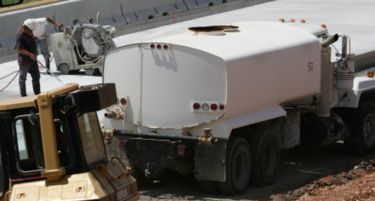Difference between revisions of "1070.3 Laboratory Testing Guidelines for Sec 1070"
m (→1070.3.3 Sample Record: updated link) |
m (Per CM, removed archaic SiteManager info and replaced with AASHTOWARE info) |
||
| (2 intermediate revisions by the same user not shown) | |||
| Line 2: | Line 2: | ||
This article establishes procedures for Laboratory testing and reporting water that is to | This article establishes procedures for Laboratory testing and reporting water that is to | ||
| − | be used in mixing and curing Portland cement concrete, mortar and grout. Refer to [http://www.modot. | + | be used in mixing and curing Portland cement concrete, mortar and grout. Refer to [http://www.modot.org/business/standards_and_specs/SpecbookEPG.pdf#page=14 Sec 1070] for MoDOT's specifications. |
===1070.3.1 Sample Preparation=== | ===1070.3.1 Sample Preparation=== | ||
| Line 8: | Line 8: | ||
===1070.3.2 Procedure=== | ===1070.3.2 Procedure=== | ||
| − | Chemical and physical tests on water samples shall be conducted according to the methods set forth in AASHTO T26. The pH test is performed according to standard laboratory practice. If the pH test shows that the sample is out of the acceptable pH range or if the sample contains oil, acid, alkali, salt, or organic matter, then determine the autoclave expansion and 7-day compressive strength as described in the specification. Original test data and calculations shall be recorded in Laboratory workbooks. Test results shall then be recorded through | + | Chemical and physical tests on water samples shall be conducted according to the methods set forth in AASHTO T26. The pH test is performed according to standard laboratory practice. If the pH test shows that the sample is out of the acceptable pH range or if the sample contains oil, acid, alkali, salt, or organic matter, then determine the autoclave expansion and 7-day compressive strength as described in the specification. Original test data and calculations shall be recorded in Laboratory workbooks. Test results shall then be recorded through AASHTOWARE Project (AWP). |
===1070.3.3 Sample Record=== | ===1070.3.3 Sample Record=== | ||
| − | The sample record shall be completed in | + | The sample record shall be completed in AWP, as described in [[106.20 Reporting#106.20.1.1 Automation Section|Automation Sec]], and shall indicate acceptance, qualified acceptance, or rejection. Appropriate remarks, as described in [[106.20 Reporting|EPG 106.20 Reporting]], are to be included in the remarks to clarify conditions of acceptance or rejection. Test results shall be reported on the appropriate templates under the Tests tab. |
[[Category:1070 Water]] | [[Category:1070 Water]] | ||
Latest revision as of 10:06, 19 October 2021
This article establishes procedures for Laboratory testing and reporting water that is to be used in mixing and curing Portland cement concrete, mortar and grout. Refer to Sec 1070 for MoDOT's specifications.
1070.3.1 Sample Preparation
Immediately prior to starting all tests on water, the sample as received in the laboratory should be agitated.
1070.3.2 Procedure
Chemical and physical tests on water samples shall be conducted according to the methods set forth in AASHTO T26. The pH test is performed according to standard laboratory practice. If the pH test shows that the sample is out of the acceptable pH range or if the sample contains oil, acid, alkali, salt, or organic matter, then determine the autoclave expansion and 7-day compressive strength as described in the specification. Original test data and calculations shall be recorded in Laboratory workbooks. Test results shall then be recorded through AASHTOWARE Project (AWP).
1070.3.3 Sample Record
The sample record shall be completed in AWP, as described in Automation Sec, and shall indicate acceptance, qualified acceptance, or rejection. Appropriate remarks, as described in EPG 106.20 Reporting, are to be included in the remarks to clarify conditions of acceptance or rejection. Test results shall be reported on the appropriate templates under the Tests tab.
